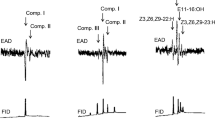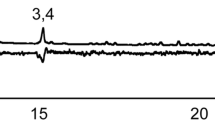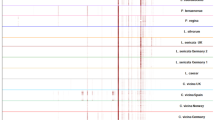Abstract
Various nonpolar and weakly polar organic solvent extracts of femaleLucilia cuprina caused more flies to be trapped in conical flasks, placed in cages of blowflies, than in untreated flasks or in flasks treated with similar extracts of maleL. cuprina. This is attributed to an attractant present in the extracts of female flies, and since more females than males tended to be trapped, the attractant (or pheromone) possibly plays a role in the group oviposition behavior exhibited by this species. The data from experiments and gas-liquid chromatography (GLC) examinations of dichloromethane and hexane extracts of flies suggest that the attractant is a cuticular lipid.
Similar content being viewed by others
References
Barton Browne, L., Bartell, R.J., andShorey, H.H. 1969. Pheromone-mediated behaviour leading to group oviposition in the blowflyLucilia cuprina.J. Insect Physiol. 15:1003–1014.
Bay, D.E., andPitts, C.W. 1977. Face fly communal oviposition.J. Kans. Entomol. Soc. 50:244–246.
Brossut, R. 1975. Pheromonal bases of gregarism and interattraction, pp. 67–85,in C. Noirot, P.E. Howse, and G. LeMasne (eds.). Pheromones and Defensive Secretions in Social Insects. Proc. Symp., Dijon.
Byrne, K.J., Gore, W.E., Pearce, G.T.,andSilverstein, R.M. 1975. Poropak-Q collection of airborne organic compounds serving as models for insect pheromones.J. Chem. Ecol. 1:1–7.
Carlson, D.A., andBeroza, W. 1973. Field evaluations of (Z)-9-tricosene, a sex attractant pheromone of the house fly.Environ. Entomol. 2:555–557.
Carlson, D.A., Langley, P.A., andHuyton, P. 1978. Sex pheromone of the tsetse fly: Isolation, identification and synthesis of contact aphrodisiacs.Science 201:750–753.
Ghizdavu, I. 1978. Influence of the factors sex and age on sensitivity of adults ofMusca domestica L. to the sexually specific pheromone (Z)-9-tricosene.Stud. Cercet. Biol. Anim. 30:41–44.
Girard, J.E., andBudris, J.P. 1975. Sex pheromone in the flesh fly,Sarcophaga bullata. Melsheimer Entomol Ser. (U.S.) No. 20.
Goodrich, B.S. 1970. Cuticular lipids of adults and puparia of the Australian sheep blowflyLucilia cuprina (Wied.).J. Lipid Res. 11:1–6.
Greenblatt, R.E., Burkholder, W.E., Cross, J.H., Cassidy, R.F., Silverstein, R.M., Levinson, A.R., andLevinson, H.Z. 1977. Chemical basis for interspecific responses to sex pheromones ofTrogoderma species (Coleoptera: Dermestidae).J. Chem. Ecol. 3:337–347.
Harris, R.L., Oehler, D.D., andBerry, I.L. 1976. Sex pheromone of the stable fly: Effect of age, sex, species, and mating on content of cuticular hydrocarbons.Environ. Entomol. 5:973–977.
Kostelc, J.G., Hendry, L.B., andSnetsinger, R.J. 1975. A sex pheromone complex of the mushroom-infesting sciarid fly,Lycoriella mali Fitch.J. N. Y. Entomol. Soc. 83:255–256.
Lang, J.T. 1977. Contact sex pheromone in the mosquito,Culiseta inornata (Diptera: Culicidae).J. Med. Entomol. 14:448–454.
Langley, P.A., Pimley, R.W., andCarlson, D.A. 1975. Sex recognition pheromone in tsetse flyGlossina morsitans.Nature 254:51–53.
Linley, J.R., andCarlson, D.A. 1978. A contact mating pheromone in the biting midge,Culicoides melleus.J. Insect Physiol. 24:423–427.
Mackerras, I.M., andFuller, M.E. 1937. A survey of the Australian sheep blowflies.J. Coun. Sci. Ind. Res. (Aust.) 10:261–270.
Mayer, M.S., Silhacek, D.L., Carlson, D.A., andJames, J.D. 1972. Attraction of the male housefly to cuticular hydrocarbons and feces of several other dipteran species.Experientia 28:1111–1112.
Murray, M.D. 1978. The species of flies reared from struck sheep in western Australia.Aust. Vet. J. 54:262.
Richter, I., Krain, H.,andMangold, H.K., 1976. Long-chain(Z)-9-alkenes are “psychedelics” to houseflies with regard to visually stimulated sex attraction and aggregation.Experientia 32:186–188.
Snedecor, G.W. 1956. Statistical Methods Applied to Experiments in Agriculture and Biology, p. 315. Iowa State College Press, Ames, Iowa.
Sonnet, P.E., Uebel, E.C., Harris, R.L., andMiller, R.W. 1977. Sex pheromone of the stable fly: Evaluation of methyl- and 1,5-dimethylalkanes as mating stimulants.J. Chem. Ecol. 3:245–249.
Uebel, E.C., Sonnet, P.E., Miller, R.W., andBeroza, M. 1975. Sex pheromone of the face fly,Musca autumnalis De Geer (Diptera: Muscidae).J. Chem. Ecol. 1:195–201.
Uebel, E.C., Sonnet, P.E., andMiller, R.W. (1976). Housefly sex pheromone: Enhancement of mating strike activity by combination of (Z)-9-tricosene with branched saturated hydrocarbons.Environ. Entomol. 5:905–908.
Uebel, E.C., Sonnet, P.E., Menzer, R.E., Miller, R.E., andLusby, W.R. 1977, Mating-stimulant pheromone and cuticular lipid constituents of the little housefly,Fannia canicularis (L.).J. Chem. Ecol. 3:269–278.
Uebel, E.C., Schwarz, M., Menzer, R.E., andMiller, R.W. 1978a. Mating stimulant pheromone and cuticular lipid constituents ofFannia pusio (Weidemann) (Diptera: Muscidae).J. Chem. Ecol. 4:73–81.
Uebel, E.C., Schwarz, M., Miller, R.W., andMenzer, R.E. 1978b. Mating stimulant pheromone and cuticular lipid constituents ofFannia femoralis (Stein) (Diptera: Muscidae).J. Chem. Ecol. 4:83–93.
Uebel, E.C., Schwarz, M., Lusby, W.R., Miller, R.W., andSonnet, P.E. 1978c. Cuticular non-hydrocarbons of the female housefly and their evaluation as mating stimulants.Lloydia 41:63–67.
Yinon, U., Shulov, A., andIkan, R. 1971. The olfactory responses of granary beetles towards natural and synthetic fatty acid esters.J. Insect Physiol. 17:1037–1049.
Waterhouse, D.F. 1947. The relative importance of live sheep and of carrion as breeding grounds for the Australian sheep blowflyLucilia cuprina. Bull. Coun. Sci. Ind. Res. (Aust.) No. 217.
Watts, J.E., Muller, M.J., andDyce, A.L. 1976. The species offlies reared from struck sheep in south-eastern Australia.Aust. Vet. J. 52:488–489.
Author information
Authors and Affiliations
Rights and permissions
About this article
Cite this article
Emmens, R.L. Evidence for an attractant in cuticular lipids of femaleLucilia cuprina (Wied.), Australian sheep blowfly. J Chem Ecol 7, 529–541 (1981). https://doi.org/10.1007/BF00987701
Received:
Revised:
Issue Date:
DOI: https://doi.org/10.1007/BF00987701




